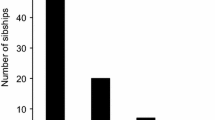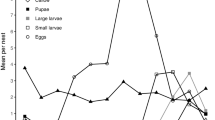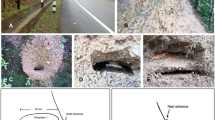Abstract
For many organisms, choosing an appropriate nest site is a critical component of reproductive fitness. Here we examine nest site selection in the solitary, resource defense polygynous bee, Anthidium manicatum. Using a wood-framed screen enclosure outfitted with food sources, nesting materials, and bamboo trap nests, we show that female bees prefer to initiate nests in sites located high above the ground. We also show that nest sites located at higher levels are less likely to contain spiderwebs, suggesting an adaptive explanation for nest site height preferences. We report size differences between this study’s source populations in Boston, Massachusetts and Brooklyn, New York; male bees collected in Boston have smaller mean head widths than males collected in Brooklyn. Finally, we argue that methods for studying captive populations of A. manicatum hold great promise for research into sexual selection, alternative phenotypes, recognition systems, and the evolution of nesting behavior.
Similar content being viewed by others
References
Cytel (2003) StatXact 6®. Cytel Software Corporation, Cambridge, MA.
Darwin C. (1871) The descent of man, and selection in relation to sex, in: Wilson E.O. (Ed.) From so simple a beginning: the four great books of Charles Darwin, W. W. Norton & Co., New York, pp. 978–979.
Gibbs J., Sheffield C.S. (2009) Rapid range expansion of the wool-carder bee, Anthidium manicatum (Linnaeus) (Hymenoptera: Megachilidae), in North America, J. Kans. Entomol. Soc. 82, 21–29.
Kirby W., Spence W. (1857) An introduction to entomology, or elements of the natural history of insects, 7th ed. Longman, Brown, Green, Longmans, & Roberts, London.
Kurtak B.H. (1973) Aspects of the biology of the European bee Anthidium manicatum (Hymenoptera: Megachilidae) in New York State, MS thesis, Cornell University.
Melander A.L. (1902) The nesting habits of Anthidium, Biol. Bull. 3, 27–32.
Michener C.D. (2000) The bees of the world, The Johns Hopkins University Press, Baltimore, pp. 474–520.
Müller U.G. (1987) Dimorphic males in the European wool-carder bee Anthidium manicatum (Megachilidae: Hymenoptera), MS thesis, Cornell University.
Pechuman L.L. (1967) Observations on the behavior of the bee Anthidium manicatum (L.), J. N.Y. Entomol. Soc. 75, 68–73.
Severinghaus L.L., Kurtak B.H., Eickwort G.C. (1981) The reproductive behavior of Anthidium manicatum (Hymenoptera: Megachilidae) and the significance of size for territorial males, Behav. Ecol. Sociobiol. 9, 51–58.
Shreeves G., Field J. (2008) Parental care and sexual size dimorphism in wasps and bees, Behav. Ecol. Sociobiol. 62, 843–852.
Smith F. (1855) Catalogue of British Hymenoptera in the collection of the British Museum, part I: Apidae - bees, Taylor & Francis, London, pp. 184–187.
SPSS (2008) SPSS GradPack® version 17.0 for Windows. SPSS, Inc., Chicago (IL).
Starks P.T., Reeve H.K. (1999) Condition-based alternative reproductive tactics in the wool-carder bee, Anthidium manicatum, Ethol. Ecol. Evol. 11, 71–75.
Sugiura N. (1994) Parental investment and offspring sex ratio in a solitary bee, Anthidium semptemspinosum Lepeletier (Hymenoptera: Megachilidae), J. Ethol. 12, 131–139.
Vinson S.B., Frankie G.W. (2000) Nest selection, usurpation, and a function for the nest entrance plug of Centris bicornuta (Hymenoptera: Apidae), Ann. Entomol. Soc. Am. 93, 254–260.
Ward J.D. (1928) An unrecorded habit of the male of the bee Anthidium manicatum, L., Entomologist 61, 267–272.
Westrich P. (1989) Die Wildbienen Baden- Württembergs, Eugen Ulmer Verlag, Stuttgart.
Wirtz P., Szabados H., Pethig H., Plant J. (1988) An extreme case of interspecific territoriality: male Anthidium manicatum (Hymenoptera: Megachilidae) wound and kill intruders, Ethology 78, 159–167.
Author information
Authors and Affiliations
Corresponding author
Additional information
Manuscript editor: Klaus Hartfelder
Rights and permissions
About this article
Cite this article
Payne, A., Schildroth, D.A. & Starks, P.T. Nest site selection in the European wool-carder bee, Anthidium manicatum, with methods for an emerging model species. Apidologie 42, 181–191 (2011). https://doi.org/10.1051/apido/2010050
Received:
Revised:
Accepted:
Published:
Issue Date:
DOI: https://doi.org/10.1051/apido/2010050




